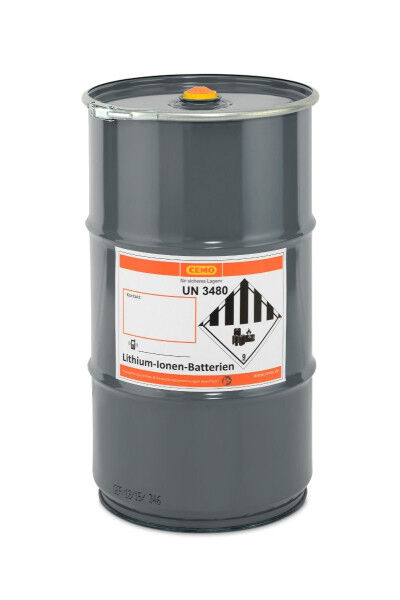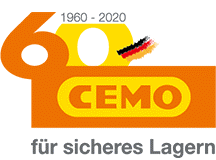
incl. VAT.
Please note: Notes on delivery time
Free shipping (Germany, mainland)!
Shippingtime: 1-2 Wochen
- Article no: CEMVG1AKST

Questions about the article?
Our staff member Petra Fürbeck is happy to help you:
+49 (0) 7151 - 256 4817 or info@lion-care.com
| Handling the filling material: | Backfill |
| max. gross mass: | 60 kg |
| Empty weight: | 6.9 kg |
| Material name: | Steel (painted) |
| Volume: | 60 l |
| Packaging group: | Packaging group I, Packaging group II |
| Packaging instructions according to ADR: | PI 903, PI 908, PI 909 |
| ADR special provision: | SP 376, SP 377 |
| UN packaging code: | 1A2 / X60 / S /... |
| Areas of application: | Power tool batteries, Recycling centers, Garden tool batteries, Model batteries |
| External dimensions: | 382 x 680 mm |
| Filling material: | Vermiculite |
| Internal dimensions: | without specification |
This safety garbage can is a simple and inexpensive system for safely storing and transporting lithium-ion batteries from eBikes, power tools, garden tools, etc. The garbage can is particularly suitable for collecting defective lithium-ion batteries and rechargeable batteries and storing them until disposal.
If required, please contact us for a customized offer.
Size, structure and function of the safety bin
The CEMO battery safety garbage can has a diameter of 382 mm and a height of 680 mm, with a capacity of 60 liters. The empty weight is approx. 6.9 kg. The garbage can is supplied with a 50-liter bag of vermiculite. When the garbage cans are full, they should not be stacked.
Features
This system is a clamping ring lid drum with a special valve to relieve pressure in the event of damage. This works on the principle of a pressure cooker. The container is supplied ex works with a plastic bag and is half filled with vermiculite filling material.
Scope of delivery
- Accumulator safety bin
- 50 liter vermiculite bag
- Large sticker with hazardous goods pictogram 9A
- Packaging instructions based on P903 and P908 of the ADR
- 2 inlay bags (650 x 1200 mm), 150 μm
- 10 inner bags for packing defective batteries (400 x 500 mm), 150 μm
- 2 cable ties
Certification and guidelines
Lithium batteries fall into dangerous goods class 9, which means that the goods pose a risk to the environment during transportation that should not be underestimated. Numerous specifications and guidelines must therefore be observed when transporting lithium batteries
Certified as packaging group I
The battery safety garbage can meets the requirements of packaging group I, which means that substances with a high hazard potential may be transported in it. UN X coding is also available.
Suitable for transportation in accordance with SV 376 of the ADR and packing instruction P 908
All lithium-ion cells or batteries and lithium-metal cells or batteries that have been damaged and no longer comply with the applicable regulations according to their manual must comply with the provisions of Special Provision 376 (SV 376). This applies, for example, to cells that have leaked or degassed, have suffered external or mechanical damage or have been identified as defective for safety reasons or could no longer be diagnosed prior to transportation. These cells must then be packed in accordance with packing instruction P 908. According to this directive, for example, it must be ensured that any electrolytes released are absorbed and a non-electrically conductive thermal insulation material must ensure that the environment is protected from dangerous heat generation.
For storage, transportation and recycling in accordance with SV 377 of the ADR and packaging instruction P 909
Special provision SV 377 regulates the transportation of lithium-ion cells or batteries and lithium-metal cells or batteries that are transported for disposal or recycling. Similar to packing instruction P 908, guidelines for packing group II must be observed in P 909. In addition, restrictions on the nominal energy and weight of lithium-ion cells and batteries apply.
The manufacturer
CEMO GmbH from Weinstadt has stood for safe storage with imagination and energy for more than 60 years. The company is a pioneer in the field of modern transportation and storage container technology and is one of the market leaders in this area.
Future-oriented
Lithium-ion batteries will be indispensable in all industrial applications in the coming years. However, if used improperly, batteries can pose a potential hazard during production, storage and transportation that should not be underestimated. By purchasing this safety buoy, you protect yourself against major financial losses right from the start.
In use for you
If you have any questions, please do not hesitate to contact us. We look forward to hearing from you!
| Handling the filling material: | Backfill |
| max. gross mass: | 60 kg |
| Coding: | 1A2 |
| Filling material supplied: | Vermiculite (bulk material) |
| Volume: | 0 - 84 l |
| Type of packaging: | Dangerous goods packaging < 450 liters or < 400 kg net |
| Material: | Steel |
| Type: | Storage barrel |
| Empty weight: | 6.9 kg |
| Suitable for critically defective?: | No |
| Material name: | Steel (painted) |
| Volume: | 60 l |
| Packaging group: | Packaging group I, Packaging group II |
| Packaging instructions according to ADR: | PI 903, PI 908, PI 909 |
| ADR special provision: | SP 376, SP 377 |
| UN packaging code: | 1A2 / X60 / S /... |
| Areas of application: | Power tool batteries, Recycling centers, Garden tool batteries, Model batteries |
| External dimensions: | 382 x 680 mm |
| Filling material: | Vermiculite |
| Internal dimensions: | without specification |
That depends on various factors that need to be considered:
- size of the battery(ies)
- condition (e.g. non-critical, defective, critically defective or prototype)
- power
Transport boxes are available in many different sizes and specifications. The packaging group for which the box is suitable is indicated for each product.
Find out more in our blog article:
https://www.lion-care.com/aktuelles/blog/transportvorschriften-regeln-und-sicherheitsmassnahmen
Even if the batteries are not critical, remember to protect them from shocks and to order appropriate filling material if it is not already included in the box.
Yes. Should a battery reach a critical state and cause a fire, separating the batteries will prevent the fire from spreading and multiplying.
Generally, the insulation and protection material should line all sides of the container. The batteries are stored between individual layers.
We also have containers in our program that already have the protective material integrated into the outer wall. No further protective layer is necessary here.
The technical principles for storage and transportation solutions are very similar. The transport boxes are also subjected to extensive tests in accordance with ADR (drop test, fire test, etc.) to confirm compliance with the ADR regulations. The packaging regulations are extensive and regulated by law.
There are currently no comparable regulations for storage. Nevertheless, manufacturers of storage boxes regularly carry out appropriate tests.
The right container depends on the type and size of the battery to be shipped or stored.
If you want to learn more about battery storage and transportation, you will find the answers in our blog articles:
https://www.lion-care.com/aktuelles/blog/transportvorschriften-regeln-und-sicherheitsmassnahmen
https://www.lion-care.com/aktuelles/blog/lithium-ionen-akkus-sicherer-umgang-und-richtige-lagerung
The transportation of batteries is subject to ADR regulations.
The number, size and weight, energy density and condition of the batteries are crucial parameters for finding a suitable transport container for lithium-ion batteries. The selection process is complex and should be carried out by appropriately trained personnel. We have a trained hazardous materials officer on our team. Please feel free to contact us.
Plastic containers are cheaper but not as durable as metal containers. They are suitable, for example, for non-critical batteries, defective batteries, prototypes and end-of-life batteries. They can be used for both storage and transportation.
Metal containers are required, for example, when dealing with critically defective batteries.
The exact packaging instructions for these cases can be found in the ADR or by consulting a certified hazardous materials specialist.
To date, there are no legal requirements for the storage of lithium-ion batteries, which does not mean that they should be stored without suitable protective measures.
It is best to check with your insurer to find out which measures they recognize as suitable in the event of a claim.
For example, a suitable box could already be recognized as spatial separation.
A rough overview can be found in this VDS publication from the GDV:
https://shop. vds.de/download/vds-3103/ccb1d439-ad9d-47cb-a2b1-ace23e155610
Please also read our blog article on this topic:
https://www.lion-care.com/aktuelles/blog/lithium-ionen-akkus-sicherer-umgang-und-richtige-lagerung




